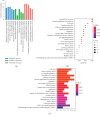Comprehensive Analysis of lncRNA-Mediated ceRNA Crosstalk and Identification of Prognostic Biomarkers in Wilms' Tumor
- PMID: 32149111
- PMCID: PMC7057018
- DOI: 10.1155/2020/4951692
Comprehensive Analysis of lncRNA-Mediated ceRNA Crosstalk and Identification of Prognostic Biomarkers in Wilms' Tumor
Abstract
Wilms' tumor (WT) is the most common type of childhood kidney cancer, and most cases present with favorable histology and respond well to standard treatment. However, a subset of patients with WT is diagnosed with bilateral, relapsed, and high-risk tumors which remain the leading cause of cancer-related death in children. Long noncoding RNAs (lncRNAs) and their aberrant expression have currently been attracting great attention as oncogenes or tumor suppressors during tumor initiation and progression. So far, their roles and related competitive endogenous RNA (ceRNA) network remain unelucidated in nephroblastoma pathogenesis. We comprehensively integrated lncRNA, microRNA (miRNA), and messenger RNA (mRNA) expression profiles from the Therapeutically Applicable Research to Generate Effective Treatment (TARGET) database and screened out differentially expressed mRNAs (DEMs), lncRNAs (DELs), and miRNAs (DEMis) to construct a ceRNA network based on the information generated from miRcode, miRTarBase, TargetScan, and miRDB. Gene ontology (GO) and Kyoto Encyclopedia of Genes and Genomes (KEGG) pathway enrichment analyses were performed to analyze the functional characteristics of DEMs in the ceRNA network. The interaction between protein molecules was also analyzed by establishing a protein-protein interaction network. Finally, prognosis-related biomarkers were identified via survival analysis. Initially, 1647 DELs, 115 DEMis, and 3280 DEMs (|log FC| > 2; FDR < 0.01) were obtained using the R package. Next, we constructed a lncRNA-miRNA-mRNA network (ceRNA network), in which 176 DELs, 24 DEMis, and 141 DEMs were identified. Furthermore, 148 functional enrichment terms from GO were identified and 29 KEGG pathways were found to be significantly enriched. We also integrated patient clinical information to analyze the association between DERNAs and patient prognosis. We found that high expression of 8 DELs (LINC00473, AL445228.2, DENND5B-AS1, DLEU2, AC123595.1, AC135178.1, LINC00535, and LMO7-AS1) and 4 DEMs (CEP55, DEPDC1, PHF19, and TRIM36) correlated with poor survival in a patient with WT, whereas high expression of 2 DELs (MEG3 and RMST), 1 DEM (KIAA0922), and 1 DEMi (hsa-mir-200a) could possibly lead to better clinical outcomes. For the first time, the present study provided a novel insight into lncRNA-related ceRNA networks and identified potential prognostic biomarkers in Wilms' tumor.
Copyright © 2020 Hong Zheng et al.
Conflict of interest statement
The authors declare that they have no conflicts of interests.
Figures







Similar articles
-
Comprehensive Analysis of a Long Noncoding RNA-Associated Competing Endogenous RNA Network in Wilms Tumor.Cancer Control. 2020 Apr-Jun;27(2):1073274820936991. doi: 10.1177/1073274820936991. Cancer Control. 2020. PMID: 32597194 Free PMC article.
-
Excavating novel diagnostic and prognostic long non-coding RNAs (lncRNAs) for head and neck squamous cell carcinoma: an integrated bioinformatics analysis of competing endogenous RNAs (ceRNAs) and gene co-expression networks.Bioengineered. 2021 Dec;12(2):12821-12838. doi: 10.1080/21655979.2021.2003925. Bioengineered. 2021. PMID: 34898376 Free PMC article.
-
Competitive endogenous RNA (ceRNA) regulation network of lncRNAs, miRNAs, and mRNAs in Wilms tumour.BMC Med Genomics. 2019 Dec 16;12(1):194. doi: 10.1186/s12920-019-0644-y. BMC Med Genomics. 2019. PMID: 31842887 Free PMC article.
-
Reconstruction and Analysis of the Differentially Expressed IncRNA-miRNA-mRNA Network Based on Competitive Endogenous RNA in Hepatocellular Carcinoma.Crit Rev Eukaryot Gene Expr. 2019;29(6):539-549. doi: 10.1615/CritRevEukaryotGeneExpr.2019028740. Crit Rev Eukaryot Gene Expr. 2019. PMID: 32422009 Review.
-
Identification of MFI2-AS1, a Novel Pivotal lncRNA for Prognosis of Stage III/IV Colorectal Cancer.Dig Dis Sci. 2020 Dec;65(12):3538-3550. doi: 10.1007/s10620-020-06064-1. Epub 2020 Jan 20. Dig Dis Sci. 2020. PMID: 31960204 Review.
Cited by
-
Long Noncoding RNA Small Nucleolar Host Gene: A Potential Therapeutic Target in Urological Cancers.Front Oncol. 2021 Apr 22;11:638721. doi: 10.3389/fonc.2021.638721. eCollection 2021. Front Oncol. 2021. PMID: 33968736 Free PMC article. Review.
-
Transcription factor HOXB2 upregulates NUSAP1 to promote the proliferation, invasion and migration of nephroblastoma cells via the PI3K/Akt signaling pathway.Mol Med Rep. 2022 Jun;25(6):205. doi: 10.3892/mmr.2022.12721. Epub 2022 Apr 29. Mol Med Rep. 2022. PMID: 35485274 Free PMC article.
-
Deleted in lymphocytic leukemia 2 (DLEU2): a possible biomarker that holds promise for future diagnosis and treatment of cancer.Clin Transl Oncol. 2023 Oct;25(10):2772-2782. doi: 10.1007/s12094-023-03149-x. Epub 2023 Apr 24. Clin Transl Oncol. 2023. PMID: 37095423 Free PMC article. Review.
-
Long Noncoding RNA WEE2-AS1 Plays an Oncogenic Role in Glioblastoma by Functioning as a Molecular Sponge for MicroRNA-520f-3p.Oncol Res. 2021 Mar 16;28(6):591-603. doi: 10.3727/096504020X15982623243955. Epub 2020 Aug 24. Oncol Res. 2021. PMID: 32838835 Free PMC article.
-
FOXO3a‑modulated DEPDC1 promotes malignant progression of nephroblastoma via the Wnt/β‑catenin signaling pathway.Mol Med Rep. 2022 Aug;26(2):272. doi: 10.3892/mmr.2022.12788. Epub 2022 Jul 7. Mol Med Rep. 2022. PMID: 35795985 Free PMC article.
References
MeSH terms
Substances
LinkOut - more resources
Full Text Sources
Medical

